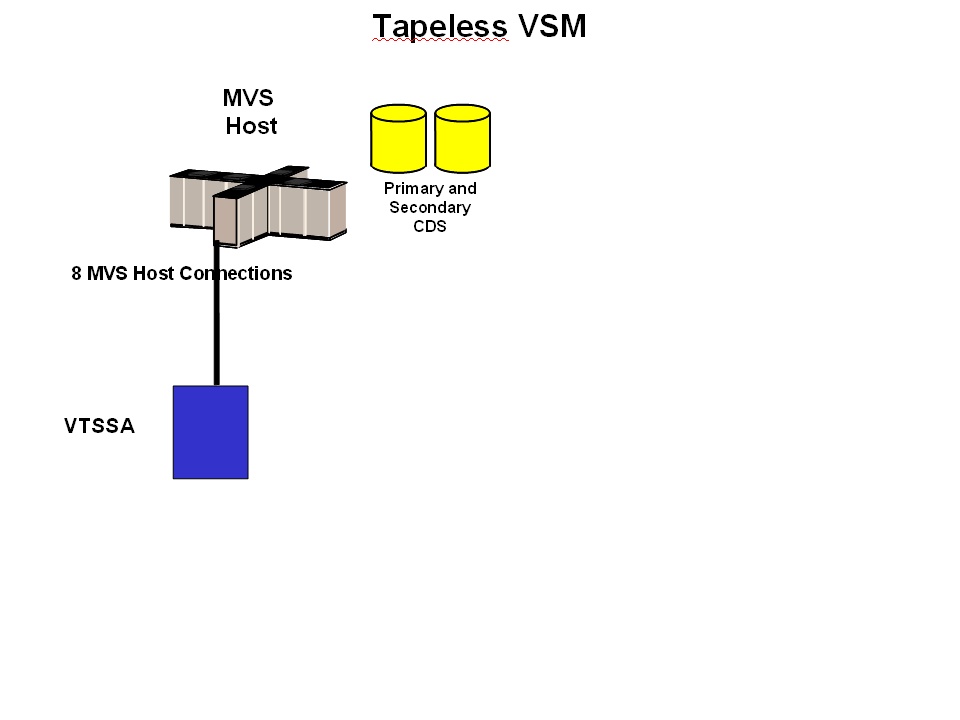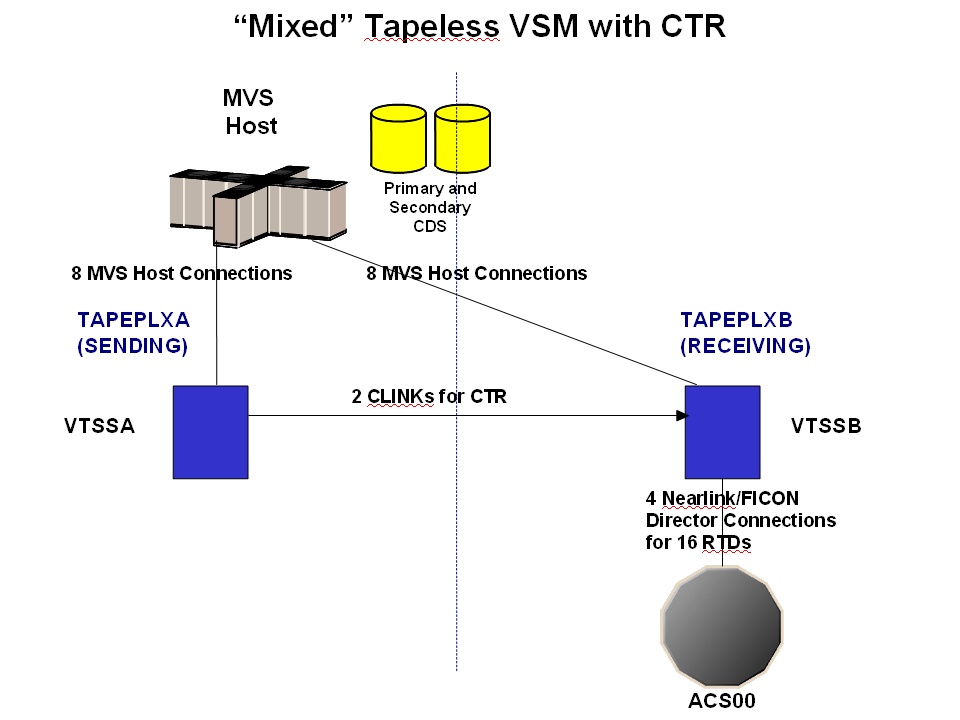L Tapeless VSM
"Tapeless VSM" basically means that you can have a VTSS without any RTDs directly attached to the VTSS; in the CONFIG deck, there are no RTD statements for the tapeless VTSS. Tapeless VSM applies to VSM4s and VSM5s.
How Does Tapeless VSM Work?
Configuring and managing a Tapeless VSM works as follows:
-
In the CONFIG deck, there are no RTD statements for the Tapeless VTSS.
Note:
For clustered VTSS configurations, all VTSSs in the cluster must be Tapeless or all VTSSs in the cluster must have RTDs attached. You cannot mix Tapeless VTSSs and VTSSs with RTDs attached within a cluster. -
The new MGMTCLAS NOMIGRAT parameter specifies that VTVs in the Management Class are not candidates for migration, consolidation or export, but are candidates to reside on a tapeless VTSS.
VTSS selection is changed to prefer Tapeless VTSSs for VTVs in Management Classes with NOMIGRAT, and to disallow VTVs without NOMIGRAT from VTSSs with no RTDs.
NOMIGRAT parameter is mutually exclusive with the ACSLIST, IMMEDMIG, DUPLEX, MIGPOL, ARCHAGE, ARCHPOL, RESTIME, CONSRC and CONTGT parameters.
-
A Management Class can specify DELSCR(YES), which is a proactive method to cause VSM to delete scratched VTVs, which frees VTSS buffer space and (logically) deletes any VTV copies from MVCs so that MVC space can be reclaimed. As an alternative, you can specify DELSCR(NO) and use the DELETSCR utility (which now provides a VTSS parameter to scratch VTVs on a per VTSS basis) to do demand deletes of scratched VTVs.
For a sample configuration, see "Tapeless VSM Example."
Note:
If you have an environment that is completely Tapeless (no RTDs attached to any VTSS system), then in your LIBGEN you need to code a dummy ACS as shown in the example in "LIBGEN Example for Tapeless ACS."
Tapeless VSM Example
Figure L-1 shows a simple Tapeless VSM configuration where VTSSA has no RTDs attached.
Configuring the System
To configure the example system shown in Figure L-1, code a CONFIG deck as shown in the following example.
In this example, note that there are no RTD statements for VTSSA because it is Tapeless.
//CREATECF EXEC PGM=SWSADMIN,PARM='MIXED' //STEPLIB DD DSN=hlq.SLSLINK,DISP=SHR //SLSCNTL DD DSN=FEDB.VSMLMULT.DBASEPRM,DISP=SHR //SLSCNTL2 DD DSN=FEDB.VSMLMULT.DBASESEC,DISP=SHR //SLSSTBY DD DSN=FEDB.VSMLMULT.DBASETBY,DISP=SHR //SLSPRINT DD SYSOUT=* //SLSIN DD * CONFIG RESET CDSLEVEL(V62ABOVE) GLOBAL MAXVTV=32000 MVCFREE=40 VTVATTR=SCRATCH RECALWER=YES LOCKSTR=VTCS_LOCKS REPLICAT=CHANGED VTVPAGE=LARGE MAXRTDS=32 RECLAIM THRESHLD=70 MAXMVC=40 START=35 VTVVOL LOW=905000 HIGH=999999 SCRATCH VTVVOL LOW=C00000 HIGH=C25000 SCRATCH VTVVOL LOW=RMM000 HIGH=RMM020 SCRATCH MVCVOL LOW=N25980 HIGH=N25989 MVCVOL LOW=N35000 HIGH=N35999 VTSS NAME=VTSSA� VTD LOW=8900 HIGH=89FF
Defining Policies
To define policies for the example system shown in Figure L-2, do the following:
-
Enable the Advanced Management Feature.
-
Create a Storage Class for VTSSA.
STOR NAME(TAPEL)
-
Create the Management Classes that point to the Storage Classes in Step 2.
MGMT NAME(TAPEL) NOMIGRAT DELSCR(YES)
In this example you created a Management Class that points to the corresponding Storage Class created in Step 2.
Note:
In addition to NOMIGRAT, the Management Class in this example specifies DELSCR(YES), which is a proactive method to cause VSM to delete scratched VTVs, which frees VTSS buffer space and (logically) deletes any VTV copies from MVCs so that MVC space can be reclaimed. As an alternative, you can specify DELSCR(NO) and use the DELETSCR utility (which now provides a VTSS parameter to scratch VTVs on a per VTSS basis) to do demand deletes of scratched VTVs. -
Create an SMC Policy that specifies virtual media and assigns the Management Class created in Step 3.
POLICY NAME(PTAPEL) MEDIA(VIRTUAL) MGMT(TAPEL)
-
Create a TAPEREQ statement to route data to VSM and assign the "Tapeless" Policy to the data.
In this example, the TAPEREQ statement specifies to route data sets with HLQ mask *.HR.** to VSM and assign Policy PTAPEL.
Note:
Although you can use SMC policies to direct your migrations to a specific esoteric, StorageTek recommends using only MGMTCLAS so that the SMC/VTCS allocation influencing can use any VTSS that supports the MGMTCLAS requirements.
Using CTR in ”Tapeless” and ”With Tape” Environments
Figure L-2 shows two non-clustered VTSSs (VTSSA and VTSSB in separate TapePlexes) where VTSSA has no RTDs attached. VTSSA sends VTVs to VTSSB using CTR so that VTSSB can migrate the VTVs to tape in ACS00.
As shown in Figure L-2, therefore, you can construct a "Tapeless" TapePlex, use CTR to connect this TapePlex to another TapePlex that has RTDs attached. With this configuration, you can make a "TapeLess" copy in the first TapePlex and replicate it to the second TapePlex where it can be migrated to tape. Refer to the ELS Disaster Recovery and Offsite Data Management Guide for more information about DTR.
LIBGEN Example for Tapeless ACS
The following examples show a LIBGEN example for a Tapeless ACS, where the SLISTATN ADDRESS=(0032) statement denotes a dummy ACS. Note that for new Tapeless VSM configurations, you can alternatively use the CDSCREAT utility as described in "Running the SLUADMIN CDSCREAT Utility to Create the CDS (Tapeless VSM Only)."
*
* LABELS WILL BE GENERATED IN THE OUTPUT LIBGEN AS FOLLOWS:
* ACS - "ACSXX" WHERE "XX" IS THE HEX ACS NUMBER 00-FF
* STARTING WITH ZERO
* LSM - "LSMXXYY" WHERE "XX" IS THE HEX ACS NUMBER OF THIS LSM
* AND "YY" IS THE HEX LSM NUMBER (00-FF) IN THAT
* ACS, STARTING AT ZERO FOR EACH NEW ACS
* STATION - "STXXH" WHERE "XX" IS THE HEX ACS NUMBER AND H IS THE
* HOST INDEX IN HEX (0-F)
* PANEL - "PXXYYPP" WHERE "XX" IS THE HEX ACS NUMBER, YY IS THE HEX
* LSM NUMBER, AND PP IS THE DECIMAL PANEL NUMBER
* OF THE DRIVE PANEL
* DRIVE - "DXXYYPPH" WHERE "XX" IS THE HEX ACS NUMBER, YY IS THE HEX
* LSM NUMBER, PP IS THE DRIVE PANEL NUMBER IN DEC
* IMAL, AND H IS THE HOST INDEX IN HEX
*
LIBGEN SLIRCVRY TCHNIQE=NONE
*
SLILIBRY SMF=231, X
ACSLIST=ACSLIST, X
HOSTID=(EC20,EC21), X
MAJNAME=STKALSQN, X
CLNPRFX=CLN, X
COMPRFX=!, X
DRVHOST=, X
SCRLABL=SL
*
ACSLIST SLIALIST ACS00
*
ACS00 SLIACS LSM=(LSM0000,LSM0001,LSM0002,LSM0003), X
STATION=(ST000,ST001)
*
ST000 SLISTATN ADDRESS=(0032)
ST001 SLISTATN ADDRESS=(0032)
*
LSM0000 SLILSM PASTHRU=((0,M),(0,M),(0,M)), X
ADJACNT=(LSM0001,LSM0002,LSM0003), X
DRIVE=(1), X
DRVELST=(P000001), X
TYPE=8500, X
DOOR=8500-2
*
P000001 SLIDLIST HOSTDRV=(D0000010,D0000010)
*
D0000010 SLIDRIVS ADDRESS=(,,,,,,,,,,,,,,,)
*
LSM0001 SLILSM PASTHRU=((0,S),(0,M),(0,M)), X
ADJACNT=(LSM0000,LSM0002,LSM0003), X
DRIVE=(1), X
DRVELST=(P000101), X
TYPE=8500, X
DOOR=8500-2
*
P000101 SLIDLIST HOSTDRV=(D0001010,D0001010)
*
D0001010 SLIDRIVS ADDRESS=(,,,,,,,,,,,,,,,)
*
LSM0002 SLILSM PASTHRU=((0,S),(0,S),(0,M)), X
ADJACNT=(LSM0000,LSM0001,LSM0003), X
DRIVE=(1), X
DRVELST=(P000201), X
TYPE=8500, X
DOOR=8500-2
*
P000201 SLIDLIST HOSTDRV=(D0002010,D0002010)
*
D0002010 SLIDRIVS ADDRESS=(,,,,,,,,,,,,,,,)
*
LSM0003 SLILSM PASTHRU=((0,S),(0,S),(0,S)), X
ADJACNT=(LSM0001,LSM0002,LSM0000), X
DRIVE=(1), X
DRVELST=(P000301), X
TYPE=8500, X
DOOR=8500-2
*
P000301 SLIDLIST HOSTDRV=(D0003010,D0003010)
*
D0003010 SLIDRIVS ADDRESS=(,,,,,,,,,,,,,,,)
*
SLIENDGN ,

